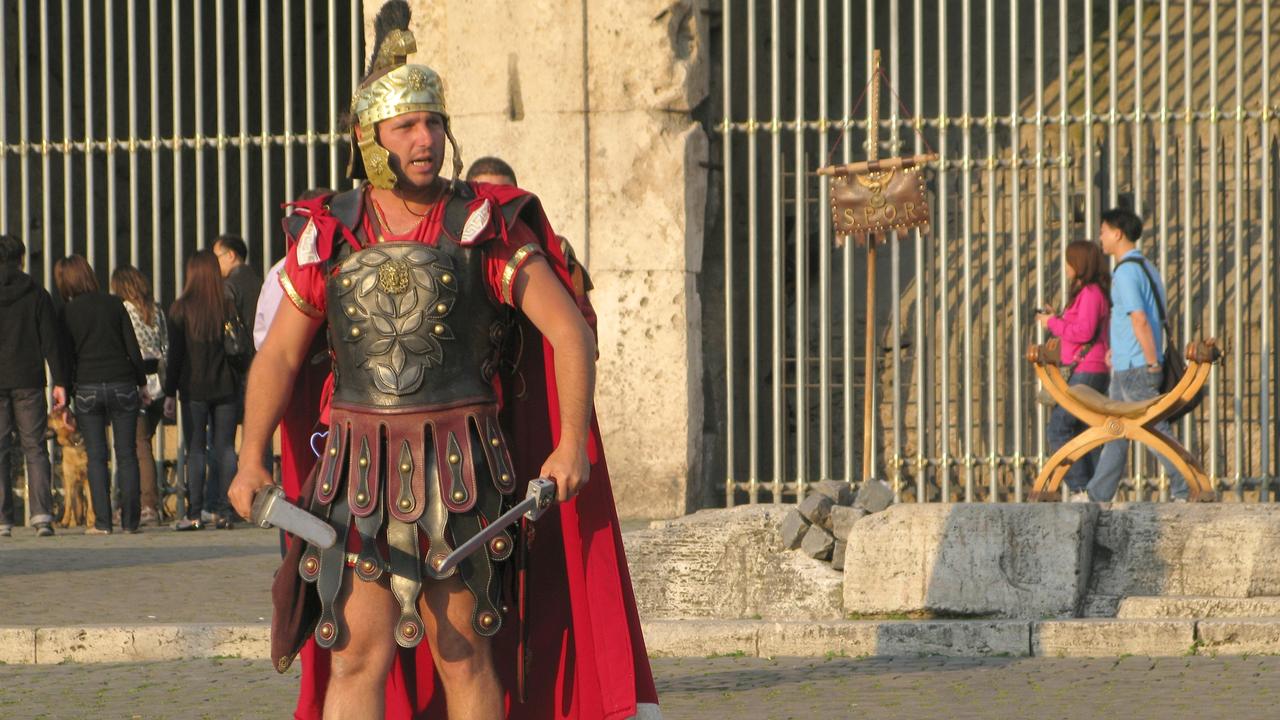Stick figure gladiators drawn by ancient kids unearthed in Pompeii
A collection of stick figure gladiator drawings discovered in the ancient city of Pompeii paint a picture of what Roman life was like for kids almost 2000 years ago

READING LEVEL: GREEN
Gladiator stick figures drawn by young children more than 2000 years ago have been unearthed in the Ancient Roman city of Pompeii.
Archaeologists discovered the charcoal sketches drawn by children as young as six while excavating the ruins of Pompeii, an ancient city near Naples.
The stick figures depict gladiators fighting in battle. Archaeologists also found the outlines of three small hands, two figures playing with a ball, a hunting scene possibly featuring a boar, and two fighters, one of whom is lying flat on the ground.
The drawings were found on the wall of a house known as the “Colonnaded Cenacle” and were probably done by children aged six or seven, said site director Dr Gabriel Zuchtriegel.

Psychologists from the Federico II University in Naples believed the sketches were drawings of things the children had seen, rather than imagined, he said.
“In Pompeii, even young children were exposed to extreme violence between humans and between humans and animals in the sands of the ancient city’s amphitheatre,” Dr Zuchtriegel said.
Gladiator fights were a popular form of entertainment in Ancient Rome. Gladiators were warriors who battled one another or animals in a public outdoor stadium known as an amphitheatre.
Many gladiators were slaves who had been purchased by wealthy businessmen and made to fight. The people of Pompeii and other Roman cities regularly filled the amphitheatre to watch the bloody, brutal battles much in the same way modern folk flock to stadiums to watch football games.

Other discoveries this week included a unique portrait of a hooded child with a small dog at his feet, found in the so-called “House of the Painters at Work”.
At the entrance of that house, the skeletons of a man and a woman were discovered, an elderly couple that had probably tried to take shelter during the volcanic eruption of Mount Vesuvius in 79AD – a disaster that wiped out the entire city.
Last month, authorities in Pompeii revealed a black-walled dining hall with paintings inspired by the Trojan War, while in March, a building site was unearthed that shed light on ancient construction techniques.

DIGGING UP POMPEII
Pompeii has long intrigued archaeologists. The Ancient Roman city was buried by volcanic ash when nearby Mount Vesuvius erupted nearly 2000 years ago in 79AD.
Its ruins were rediscovered in the late 16th Century and are still being excavated today. In fact, the techniques used in modern archaeological digs were born from the study at Pompeii and nearby Herculaneum, which was also destroyed by the eruption.
Early archaeologists studying the ancient cities found that there were hollows in the volcanic ash that once contained the remains of humans and animals that had died during the eruption. The late Italian archaeologist Giuseppe Fiorelli (1823 – 1896) developed a technique of pouring cement into the hollows to make casts of the bodies in order to study what happened when the disaster occurred.

POLL
GLOSSARY
- amphitheatre: an open, circular space surrounded by tiers of seating, first developed by the Ancient Greeks and adopted by the ancient Romans
- Trojan War: a war depicted in Ancient Greek mythology, where a large wooden horse was used to sneak Greek warriors into the Anatolian, or ancient Turkish, city of Troy. The legend is where the term “Trojan Horse” comes from
EXTRA READING
Slave room found at Pompeii
Archaeologists find ancient chariot near Pompeii
Exploring the lost city of Pompeii
QUICK QUIZ
1. Where is Pompeii?
2. How was the city destroyed?
3. What did the kids drawings found say about life in Pompeii?
4. What other discoveries were recently made in Pompeii?
5. When were the ruins of Pompeii discovered?
LISTEN TO THIS STORY
CLASSROOM ACTIVITIES
1. What do you think?
“Pompeii is a burial site, so it should not be excavated.” Do you agree with this statement? Write arguments or reasons for or against.
Time: allow at least 20 minutes to complete this activity
Curriculum Links: English, History, Personal and Social Capability
2. Extension
What evidence do you think the archaeologists used to help them decide that the sketches were drawn by children, not adults? Use information in the story and your own ideas to write a paragraph explaining your opinion.
Time: allow at least 20 minutes to complete this activity
Curriculum Links: English, History
VCOP ACTIVITY
BAB it!
Show you have read and understood the article by writing three sentences using the connectives “because’’, “and”, and “but” (BAB). Your sentences can share different facts or opinions, or the same ones but written about in different ways.

